Introduction:
Students who are ready for Zeta:- can competently add, subtract, multiply, and divide multiple-digit whole numbers
- can competently add, subtract, multiply, and divide fractions
- can competently add, subtract, multiply, and divide mixed numbers
- can determine and apply the operation(s) necessary to solve a word problem with whole numbers or fractions
Preparing for the Assessment:
You will need the following items:
- pencil with eraser
- extra paper for calculation, if desired
Student Portion:
Print out a copy of the Zeta Readiness Assessment. The printed part of the assessment is to be completed independently by the student and should take approximately 30 minutes. Be sure to keep track of the actual time your student spends on this part of the assessment. You may attempt to clarify the wording of a question if your student does not understand, but you should not answer specific questions asking how to solve a particular problem.When your student has completed his work on paper, come back to the computer to complete the rest of the assessment.
Instructor Portion:
Use this tool as an opportunity to help you determine your student’s understanding of the concepts.
For each problem, first check to see if the student answered it correctly. Then ask your student to explain to you how he arrived at each of his answers, or “teach back” the solution. Based on your student’s response, choose the statement(s) that most accurately describe how your student solved the problem. (IMPORTANT: Several of the questions require multiple responses. Be sure to mark ALL appropriate responses.)
Quiz-summary
0 of 12 questions completed
Questions:
- 1
- 2
- 3
- 4
- 5
- 6
- 7
- 8
- 9
- 10
- 11
- 12
Information
You have already completed the quiz before. Hence you can not start it again.
Quiz is loading…
You must sign in or sign up to start the quiz.
You have to finish following quiz, to start this quiz:
Results
Results
Time has elapsed
Categories
- Not categorized 0%
-
Your student’s performance indicates that he would be more successful in a previous level. Here are some additional steps you can take.
-
Your student’s performance indicates that he may be ready for Zeta. Here are some additional steps you should take.
-
Your student is ready for Zeta. The following skills were taught in previous levels of Math-U-See and are not specifically retaught in Zeta. You will want to make sure your student has mastered these skills before beginning.
- Customary measures and conversions between units (for example, converting miles to yards or pounds to ounces, comparing units of measure)
- Working with money (for example, converting between coins and dollars, making change, adding amounts of money)
- Finding the volume of a rectangular solid
- Determining the area and perimeter for squares, rectangles, parallelograms, and triangles
- Finding the fraction of a number (for example, 1/2 of 30)
- Roman numerals (convert to Arabic numerals and vice versa)
View a detailed analysis of the assessment.
Return to the Placement Assessments to try the test for the next level, Pre-Algebra.
- 1
- 2
- 3
- 4
- 5
- 6
- 7
- 8
- 9
- 10
- 11
- 12
- Answered
- Review
- Question 1 of 12
1. Question
CORRECT ANSWER: 9,983
Ask the student to explain how he determined the answer. Which of the following statements characterized his response? CLICK ALL THAT APPLY.
CorrectCORRECT ANSWER: 9,983
The student was expected to know how to multiply multiple-digit numbers using the traditional method. The student needed to demonstrate he could regroup (or “carry”) as necessary to find the product.
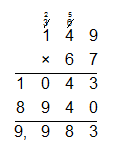
SKILL: Multiply three-digit numbers by two-digit numbers with regrouping.
IncorrectCORRECT ANSWER: 9,983
The student was expected to know how to multiply multiple-digit numbers using the traditional method. The student needed to demonstrate he could regroup (or “carry”) as necessary to find the product.

SKILL: Multiply three-digit numbers by two-digit numbers with regrouping.
- Question 2 of 12
2. Question
CORRECT ANSWER:

Ask the student to explain how he determined the answer. Which of the following statements characterized his response? CLICK ALL THAT APPLY.
CorrectCORRECT ANSWER:

The student needed to perform long division to solve the problem and write a remainder to show that he was unable to divide evenly.
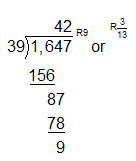
SKILL: Divide a three-digit dividend by a two-digit divisor.
IncorrectCORRECT ANSWER:

The student needed to perform long division to solve the problem and write a remainder to show that he was unable to divide evenly.

SKILL: Divide a three-digit dividend by a two-digit divisor.
- Question 3 of 12
3. Question
CORRECT ANSWER:

Ask the student to explain how he found the answer. Which of the following statements characterized his response? CLICK ALL THAT APPLY.
CorrectCORRECT ANSWER:

The student needed to simplify the fraction to lowest terms. The student could have solved this problem in one of three ways:
Solution A:
Find the prime factors of the numerator and denominator. and
and 
Next, the student needed to divide (or cancel) any common factors and multiply the remaining factors.

Solution B:
Identify the Greatest Common Factor (GCF) of the numerator and denominator. The divide the numerator and denominator by the GCF.

Solution C:
Identify a common factor of the numerator and denominator. Then divide until it is simplified to lowest terms.

SKILL: Simplify a fraction to lowest terms.
IncorrectCORRECT ANSWER:

The student needed to simplify the fraction to lowest terms. The student could have solved this problem in one of three ways:
Solution A:
Find the prime factors of the numerator and denominator. and
and 
Next, the student needed to divide (or cancel) any common factors and multiply the remaining factors.

Solution B:
Identify the Greatest Common Factor (GCF) of the numerator and denominator. The divide the numerator and denominator by the GCF.

Solution C:
Identify a common factor of the numerator and denominator. Then divide until it is simplified to lowest terms.

SKILL: Simplify a fraction to lowest terms.
- Question 4 of 12
4. Question
CORRECT ANSWER: x = 13
Ask the student to explain how he found the answer. Which of the following statements characterized his response? CLICK ALL THAT APPLY.
CorrectCORRECT ANSWER: x = 13
The student could have solved this problem in one of two ways:
Solution A:
Multiply both sides of the equation by because it is the reciprocal (opposite) of 7.
because it is the reciprocal (opposite) of 7.
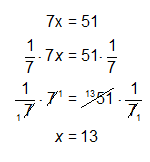
or
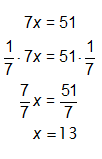
Solution B:
Divide both sides by 7 because division is the inverse (opposite)operation of multiplication.
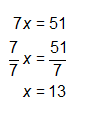
SKILL: Solve for an unknown factor.
IncorrectCORRECT ANSWER: x = 13
The student could have solved this problem in one of two ways:
Solution A:
Multiply both sides of the equation by because it is the reciprocal (opposite) of 7.
because it is the reciprocal (opposite) of 7.

or

Solution B:
Divide both sides by 7 because division is the inverse (opposite)operation of multiplication.

SKILL: Solve for an unknown factor.
- Question 5 of 12
5. Question
CORRECT ANSWER:

Ask the student to explain how he found the answer. Which of the following statements characterized his response? CLICK ALL THAT APPLY.
CorrectCORRECT ANSWER:

The student needed to multiply the fractions and express the answer in lowest terms. InZeta, students should be able to work comfortably with fractions and be able to apply efficient problem solving strategies. The student could have solved this problem in one of three ways:
Solution A:
1) Divide (cancel) common factors.
2) Multiply the fractions.

Solution B:
1) Multiply the fractions.

2) Divide the answer by the Greatest Common Factor (GCF) to simplify the answer.

Solution C:
1) Multiply the fractions.

2) Divide by several common factors to simplify the answer.

SKILL: Multiply fractions and simplify the answer to lowest terms.
IncorrectCORRECT ANSWER:

The student needed to multiply the fractions and express the answer in lowest terms. InZeta, students should be able to work comfortably with fractions and be able to apply efficient problem solving strategies. The student could have solved this problem in one of three ways:
Solution A:
1) Divide (cancel) common factors.
2) Multiply the fractions.

Solution B:
1) Multiply the fractions.

2) Divide the answer by the Greatest Common Factor (GCF) to simplify the answer.

Solution C:
1) Multiply the fractions.

2) Divide by several common factors to simplify the answer.

SKILL: Multiply fractions and simplify the answer to lowest terms.
- Question 6 of 12
6. Question
CORRECT ANSWER:

Ask the student to explain how he found the answer. Which of the following statements characterized his response? CLICK ALL THAT APPLY.
CorrectCORRECT ANSWER:

The student needed to know how to divide the fractions; then he needed to convert the answer from an improper fraction to a mixed number.
This could have been solved in one of two ways.
Solution A:
1) Multiply the first factor by the reciprocal of the second factor.
2) Change the improper fraction to a mixed number.

Solution B:
1) Find a common denominator.
2) Divide the numerators; then divide the denominators.
3) Convert the improper fraction to a mixed number.
CORRECT ANSWER:
SKILL: Divide fractions and simplify the answer to lowest terms.
IncorrectCORRECT ANSWER:

The student needed to know how to divide the fractions; then he needed to convert the answer from an improper fraction to a mixed number.
This could have been solved in one of two ways.
Solution A:
1) Multiply the first factor by the reciprocal of the second factor.
2) Change the improper fraction to a mixed number.

Solution B:
1) Find a common denominator.
2) Divide the numerators; then divide the denominators.
3) Convert the improper fraction to a mixed number.
CORRECT ANSWER:
SKILL: Divide fractions and simplify the answer to lowest terms.
- Question 7 of 12
7. Question
CORRECT ANSWER:

Ask the student to explain how he found the answer. Which of the following statements characterized his response? CLICK ALL THAT APPLY.
CorrectCORRECT ANSWER:

The student needed to know how to add mixed numbers that require regrouping by completing the following:
1) Find a common denominator for the fractions.
2) Add the fractions; then add the whole numbers.
3) Convert the improper fraction to a mixed number and regroup.
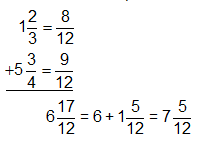
SKILL: Add mixed numbers with unlike denominators and simplify the answer to lowest terms.
IncorrectCORRECT ANSWER:

The student needed to know how to add mixed numbers that require regrouping by completing the following:
1) Find a common denominator for the fractions.
2) Add the fractions; then add the whole numbers.
3) Convert the improper fraction to a mixed number and regroup.

SKILL: Add mixed numbers with unlike denominators and simplify the answer to lowest terms.
- Question 8 of 12
8. Question
CORRECT ANSWER:

Ask the student to explain how he found the answer. Which of the following statements characterized his response? CLICK ALL THAT APPLY.
CorrectCORRECT ANSWER:

The student needed to know how to subtract mixed numbers that require regrouping (borrowing) by completing the following steps:
1) Find a common denominator.
2) Regroup (borrow) from the whole number.
3) Subtract the fractions; then subtract the whole numbers.

SKILL: Subtract mixed numbers with unlike denominators and simplify the answer to lowest terms.
IncorrectCORRECT ANSWER:

The student needed to know how to subtract mixed numbers that require regrouping (borrowing) by completing the following steps:
1) Find a common denominator.
2) Regroup (borrow) from the whole number.
3) Subtract the fractions; then subtract the whole numbers.

SKILL: Subtract mixed numbers with unlike denominators and simplify the answer to lowest terms.
- Question 9 of 12
9. Question
CORRECT ANSWER:

Ask the student to explain how he found the answer. Which of the following statements characterized his response? CLICK ALL THAT APPLY.
CorrectCORRECT ANSWER:

The problem could be solved in one of three ways:
Solution A:
1) Convert the mixed numbers to improper fractions.
2) Multiply by the reciprocal of the second factor.
3) Divide (or cancel) the common factors.
4) Multiply the numerators and denominators.
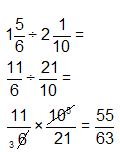
Solution B:
1) Convert the mixed numbers to improper fractions.
2) Multiply by the reciprocal of the second factor.
3) Divide the answer by the Greatest Common Factor (GCF) or another common factor.
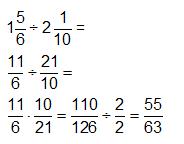
Solution C:
1) Convert the mixed numbers to improper fractions.
2) Find a common denominator.
3) Divide the numerators; then divide the denominators.

SKILL: Divide mixed numbers and simplify the answer to lowest terms.
Incorrect - Question 10 of 12
10. Question
CORRECT ANSWER:

Ask the student to explain how he found the answer. Which of the following statements characterized his response? CLICK ALL THAT APPLY.
CorrectCORRECT ANSWER:

The student had to identify the measure of the line and express the fraction in lowest terms.

SKILL: Find the measure to the nearest fraction of an inch simplified to lowest terms.
IncorrectCORRECT ANSWER:

The student had to identify the measure of the line and express the fraction in lowest terms.

SKILL: Find the measure to the nearest fraction of an inch simplified to lowest terms.
- Question 11 of 12
11. Question
The next two questions are just for the instructor to complete. Choose the statement that best describes your student’s work during the written part of the assessment.
How long did it take the student to complete the assessment? Click on the best response.
CorrectA student who has mastered the prerequisite concepts should be able to complete the written assessment in about 30 minutes.
IncorrectA student who has mastered the prerequisite concepts should be able to complete the written assessment in about 30 minutes.
- Question 12 of 12
12. Question
How often did the student ask for help or hints as to how to solve a problem? (Note: this is different than asking for clarification about how a question is worded.) Click on the best response.
CorrectA student who has mastered the prerequisite concepts should feel confident in his or her ability to solve the problems and should not need to ask for assistance.
IncorrectA student who has mastered the prerequisite concepts should feel confident in his or her ability to solve the problems and should not need to ask for assistance.